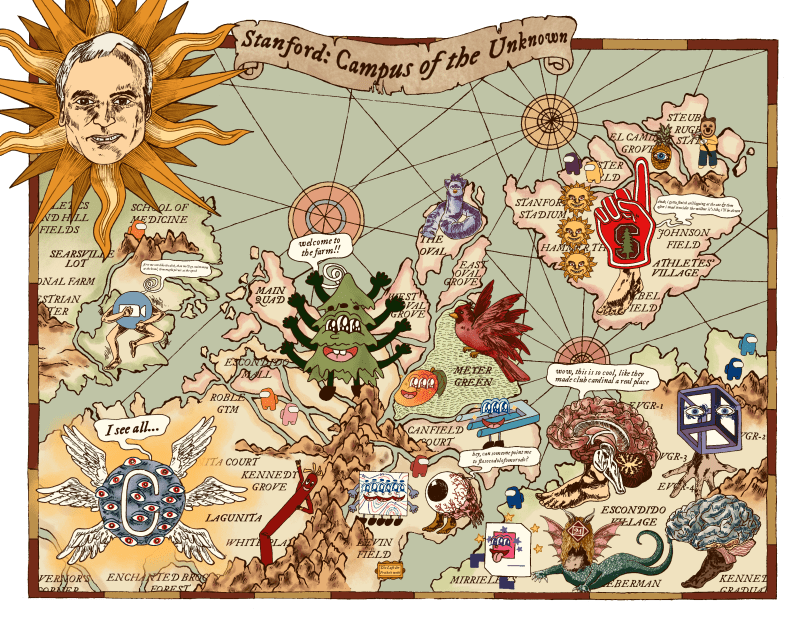After frosh fall finished, I realized I was stuck in a strange mental space of being simultaneously in Stanford and not-at-all-in. I’d gone through a certain rite of passage — bombing MATH 51 tests, sending MTL memes, stalking my insanely genius classmates’ Instagrams — that was beginning to cement my identity as a Stanford student. Yet, on a fundamental level, I still had no clue what Stanford was like as a real place, with its real Taco Bell buildings and its real palm trees and its real Arillagas and its real Enchanted Broccoli Forest.
So it was with this strange limbo state of knowing and not-knowing in mind that I decided to embark on a map-making adventure. Though I didn’t know, say, where the Dish was or what one ought to do with a FroSoCo FloMo, I knew that MTL was Canadian, that our mascot was a tree and that according to @stanfordmissedconnections there was some mysterious figure on campus that liked to pour two types of soup together and mix and drink them. All that knowledge had to count for something, I figured, so over winter break I cobbled together a mishmash of all my half-baked conceptions of Stanford onto one sprawling map.
Visually, this map drew from a hodge-podge of inspirations including 18th-century medical illustrations, medieval bestiaries, Keith Haring’s three-eyed cartoons, the contour plots I’d seen a million times in the MATH 51 textbook and, of course, terra incognita maps, most notably the 16th-century Carta Marina (which, as it happens, also provided the entire color palette for this Stanford map). This eclectic mix of aesthetic styles added a nice representation of the exhilaration of beginning college (online or not!) — just getting thrown into a setting with a bunch of new people and ideas and classes, feeling oh-so amazed and wondrously lost.
To make the map, I first hand-drew then scanned the lineart. To isolate the ink lineart from its paper background, I used the color-to-alpha function in GIMP (which sounds very fancy when I say it aloud but is really nothing more than the click of a few buttons!) Once I had the transparent linearts, it was quite simple for me to resize and rearrange the objects on canvas to create the bizarre dreamscape of the final map. With Krita, I used a wide variety of brushes to give the map a somewhat vintage, painterly feel, as well as a similar color-to-alpha function to change the lineart from black ink to softer browns and maroons. (As a quick side note, GIMP and Krita are both great free softwares! So if you get the artistic itch anytime soon… you know where to look.)
On one hand, I tried to keep the map somewhat accurate to the actual spatial zones of campus. Escondido Village, as home base of the graduate students, was stocked with walking brains, while the Athletes’ Village had a Stanford football-foam-finger-with-a-foot (as well as a hatchet-wielding Oski the Bear lurking in the background). On the other hand, I also attempted to capture a “relatable” record of the online school experience, what with its endless “Among Us” games and Zoom meetings. But for the most part, this map ended up more like the type of messy entry you scrawl in your diary after a particularly strange dream. Certain images are simply impenetrable, not only for the viewer but also myself. Why, for example, there is a tube man near Lagunita is beyond explanation. Perhaps somewhere deep in my subconscious this unknowable Stanford just gives me the “vibes” of a flailing, dancing inflatable tube man. The fantasia is close enough — and anyway, I think the overwhelming consensus right now is that being a frosh “at” Stanford this year is about as confusing and kooky as any old dream.
I won’t always be this clueless about Stanford. But for now, I’ve enjoyed seeing how my brain fills in the gaps between what little bits and bobs I know about the university to make something really silly and special. There’s sweetness in not knowing, in being able to imagine: you get to create your own little Stanford, a vision of campus made from 3 a.m. pset-session hallucinations and random GroupMe messages that ends up, oddly enough, becoming real to you. Creating your own imagined campus is a great template for introspection; it allows you to better examine your expectations and understand your own desires and interests. Think of it as a strange, convoluted sort of personality quiz — whatever you imagine about the Stanford campus says something about you, like it or not. As for me — all I’ll give away is that I can’t wait to head to campus and meet thousand-handed, three-eyed trees.
Contact The Daily’s The Grind section at thegrind ‘at’ stanforddaily.com.
